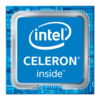Intel Celeron N4500 vs Intel Core 2 Duo T6600 vs Intel Core 2 Duo SU9300
Intel Celeron N4500
► remove from comparison
The Intel Celeron N4500 is a dual-core SoC of the Jasper Lake series that is primarily intended for inexpensive notebooks and was announced in early 2021. The two Tremont CPU cores clock between 1.1 and 2.8 GHz (single core Burst) and offer no HyperThreading. The N4500 uses 1.5 MB L2 and 4 MB L3 cache. The chip is manufactured on the first-gen 10 nm Intel process.
Architecture
The processor architecture is called Tremont and a complete redesign compared to the old Golmont Plus cores in the predecessor. According to Intel, the single thread performance of a core could is up two 30% better on average (10 - 80% in all tests of SPECint and SPECfp).
Features
In addition to the dual-core CPU block, the SoC integrates a 16 EU Intel UHD Graphics GPU clocked from 350 - 750 MHz and a dual-channel DDR4 / quad-channel LPDDR4(x) memory controller (up to 16 GB, up to 2933 MHz). The chip now also partly integrates Wi-Fi 6 (Gig+), 8 PCIe 3.0 lanes, 14 USB 2.0/ 3.2 ports and two SATA 6.0 ports. The package got bigger and measures 35 x 24 mm (compared to 25 x 24 mm for the N5030 e.g.). The SoC is directly soldered to the mainboard (BGA) and can't be easily replaced.
Performance
The average N4500 in our database shapes up to be a fairly slow processor, its multi-thread benchmark scores only just matching those of the Core i3-4010U. (The latter saw the light of day in 2013 as a lower mid-range, dual-core CPU designed for use in ultraportable laptops.) In other words, expect the Celeron to be painfully slow in all but the most basic activities.
You mileage may vary depending on how high the CPU power limits are.
Power consumption
Like most N-class Intel chips, the Celeron has a default TDP (also known as the long-term power limit) of 6 W. This is not much at all and thus good enough for passively cooled tablets, laptops, mini-PCs.
The Celeron N4500 is built with Intel's 2nd generation 10 nm process (not 10 nm SuperFin or Intel 7) for low, as of mid 2023, energy efficiency.
Intel Core 2 Duo T6600
► remove from comparisonThe Intel Core 2 Duo T6600 is an entry to mid-range dual core processor for laptops. It is based on the Penryn architecture, but features only 2 MB level 2 cache and a mediocre clock rate of 2.2 GHz. Compared to the similar T6670, the T6600 does not feature Virtualization features in hardware and is speced at a lower maximum temperature.
The performance should be suited for non demanding applications like office, internet, entry level video editing or image correction. CPU intense games may be limited by the power of the T6600.
Intel Core 2 Duo SU9300
► remove from comparisonThe Intel Core 2 Duo SU9300 is a power efficient ULV subnotebook processor based on the Penryn 3M core. It features all functions of the Penryn core, like Virtualization (VT-x), Trusted Execution and Speedstep. Due to the low core clock, the performance is limited.
| Model | Intel Celeron N4500 | Intel Core 2 Duo T6600 | Intel Core 2 Duo SU9300 | ||||||||||||||||||||||||||||||||
| Codename | Jasper Lake | Penryn | Penryn | ||||||||||||||||||||||||||||||||
| Series | Intel Jasper Lake | Intel Core 2 Duo | Intel Core 2 Duo | ||||||||||||||||||||||||||||||||
| Series: Core 2 Duo Penryn |
| ||||||||||||||||||||||||||||||||||
| Clock | 1100 - 2800 MHz | 2200 MHz | 1200 MHz | ||||||||||||||||||||||||||||||||
| L2 Cache | 1.5 MB | 2 MB | 3 MB | ||||||||||||||||||||||||||||||||
| L3 Cache | 4 MB | ||||||||||||||||||||||||||||||||||
| Cores / Threads | 2 / 2 | 2 / 2 | 2 / 2 | ||||||||||||||||||||||||||||||||
| TDP | 6 Watt | 35 Watt | 10 Watt | ||||||||||||||||||||||||||||||||
| Technology | 10 nm | 45 nm | 45 nm | ||||||||||||||||||||||||||||||||
| max. Temp. | 105 °C | 105 °C | 105 °C | ||||||||||||||||||||||||||||||||
| Socket | BGA1338 | PGA478 | BGA956 | ||||||||||||||||||||||||||||||||
| Features | DDR4-2933/LPDDR4x-2933 RAM, PCIe 3, GNA, MMX, SSE, SSE2, SSE3, SSSE3, SSE4.1, SSE4.2, SMEP, SMAP, EIST, TM1, TM2, Turbo, SST, AES-NI, RDRAND, RDSEED, SHA | Intel 64, Enhanced Speedstep, Execute Disable Bit, SSE4.1 | Enhanced Speedstep, VT, TXT | ||||||||||||||||||||||||||||||||
| iGPU | Intel UHD Graphics (Jasper Lake 16 EU) (350 - 750 MHz) | ||||||||||||||||||||||||||||||||||
| Architecture | x86 | x86 | x86 | ||||||||||||||||||||||||||||||||
| Announced | |||||||||||||||||||||||||||||||||||
| Manufacturer | ark.intel.com | ark.intel.com | ark.intel.com | ||||||||||||||||||||||||||||||||
| FSB | 800 | 800 | |||||||||||||||||||||||||||||||||
| L1 Cache | 128 KB | ||||||||||||||||||||||||||||||||||
| Transistors | 410 Million | 410 Million | |||||||||||||||||||||||||||||||||
| Voltage | 1.00-1.25V V | 1.050V-1.150V V | |||||||||||||||||||||||||||||||||
| Die Size | 107 mm2 | 107 mm2 |
Benchmarks
Average Benchmarks Intel Celeron N4500 → 100% n=2
Average Benchmarks Intel Core 2 Duo T6600 → 90% n=2
Average Benchmarks Intel Core 2 Duo SU9300 → 53% n=2
* Smaller numbers mean a higher performance
1 This benchmark is not used for the average calculation












